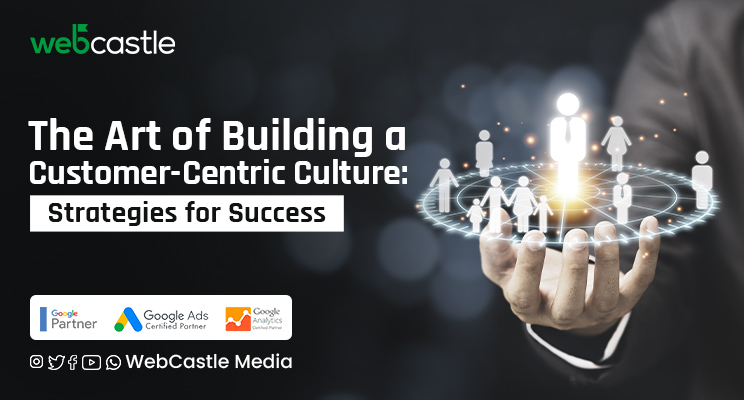In today’s competitive business landscape, success hinges on more than just offering a great product or service. It’s about building a customer-centric culture that not only attracts but also retains loyal customers. This shift in focus from product-centric to customer-centric has become paramount for businesses looking to thrive in the long term. In this blog, we will explore the art of building a customer-centric culture and discuss strategies for success.
Understanding the Customer-Centric Culture
Before diving into strategies, let’s establish a clear understanding of what a customer-centric culture entails. At its core, it’s about making customers the central focus of every aspect of your business. It means aligning your company’s values, goals, and operations with the needs and preferences of your customers.
Customer Empathy: The foundation of a customer-centric culture is empathy. It’s about putting yourself in the shoes of your customers, understanding their pain points, and striving to make their experience better.
consumer input: It is critical to actively seek and listen to consumer input. It’s not just about hearing what they say but also understanding the underlying issues and acting upon them.
Continuous Improvement: A customer-centric culture is dynamic, always seeking ways to improve and adapt. This involves not only refining products or services but also enhancing the entire customer journey.
Now that we’ve clarified what it means to be customer-centric, let’s delve into strategies to successfully build this culture within your organization.
Leadership Buy-In
Building a customer-centric culture starts at the top. Leadership must not only endorse the idea but also exemplify customer-centric behavior. When leaders prioritize customer satisfaction, it sends a clear message to the entire organization.
Action Points:
Lead by Example: Encourage leadership to actively engage with customers, respond to feedback, and prioritize customer-centric initiatives.
Align Goals: Ensure that the company’s strategic goals are aligned with improving the customer experience.
Employee Training and Engagement
Your employees are the front-line ambassadors of your customer-centric culture. They need to be equipped with the right skills and motivated to put customers first.
Action Points:
Training Programs: Develop training programs that educate employees on customer-centric principles and provide them with the tools to deliver exceptional customer experiences.
Recognition and Rewards: Recognize and reward employees who consistently demonstrate customer-centric behavior.
Data-Driven Insights
Leveraging data is essential in understanding your customers better. It helps you anticipate their needs, personalize experiences, and make informed decisions.
Action Points:
Customer Analytics: Invest in customer analytics tools to gather and analyze data related to customer behavior, preferences, and feedback.
Segmentation: Segment your customer base to tailor marketing efforts and product/service offerings to different groups.
Customer Journey Mapping
To be truly customer-centric, you must understand the entire customer journey, from awareness to post-purchase support. Mapping this journey helps identify pain points and opportunities for improvement.
Action Points:
Create Personas: Develop customer personas to represent various segments of your audience.
Map Touchpoints: Identify all touchpoints customers have with your brand and assess their experiences at each stage.
Empowerment and Autonomy
Encourage employees to take ownership of customer issues and find solutions independently.Employees that are empowered are more inclined to go above and beyond to delight clients.
Action Points:
Decision-Making Authority: Delegate decision-making authority to employees when it comes to resolving customer issues.
Feedback Loops: Establish feedback loops where employees can share customer insights and suggestions for improvements.
Communication and Transparency
Clear and honest communication builds trust with customers. Transparency in your actions and decisions demonstrates your commitment to their satisfaction.
Action Points:
Feedback Channels: Provide multiple channels for customers to provide feedback and ensure prompt responses.
Share Success Stories: Celebrate customer-centric successes within your organization to inspire others.
Continuous Evaluation and Adaptation
A customer-centric culture is not a one-time project, but rather an ongoing journey. Regularly evaluate your efforts, learn from both successes and failures, and adapt accordingly.
Action Points:
KPIs and Metrics: Establish key performance indicators (KPIs) to measure the effectiveness of your customer-centric initiatives.
Regular Reviews: Conduct regular reviews of your customer-centric strategies to identify areas that need improvement.
Customer-Centric Innovation
Innovation should be guided by customer needs and preferences. Develop a culture of innovation that puts customers at the forefront of product and service development.
Action Points:
Customer Advisory Boards: Create customer advisory boards or panels to gather direct input on new product ideas.
Prototype Testing: Involve customers in prototype testing to gather real-world feedback before product launch.
Also Read: Why Loyalty and Rewards Matter in Today’s Business World
Conclusion
Building a customer-centric culture is not a quick fix; it’s a fundamental shift in mindset and operations. However, the rewards are substantial.By focusing on your customers’ needs, you can increase customer loyalty, drive growth, and create a sustainable competitive advantage. Remember, the art of building a customer-centric culture is an ongoing journey, but the destination is a thriving, customer-centric organization that stands the test of time.

